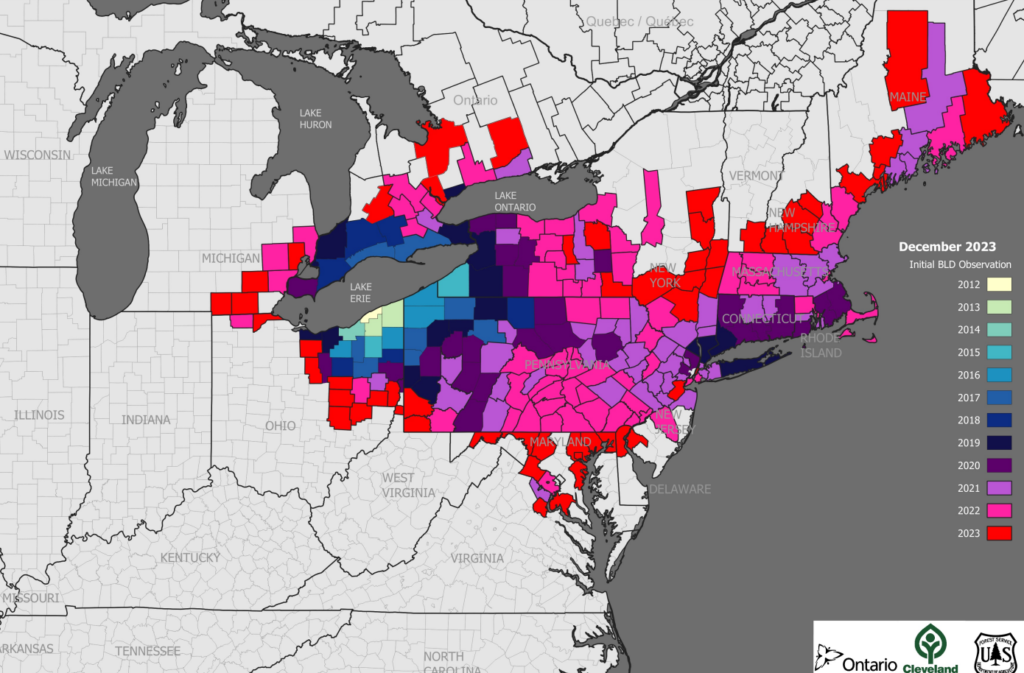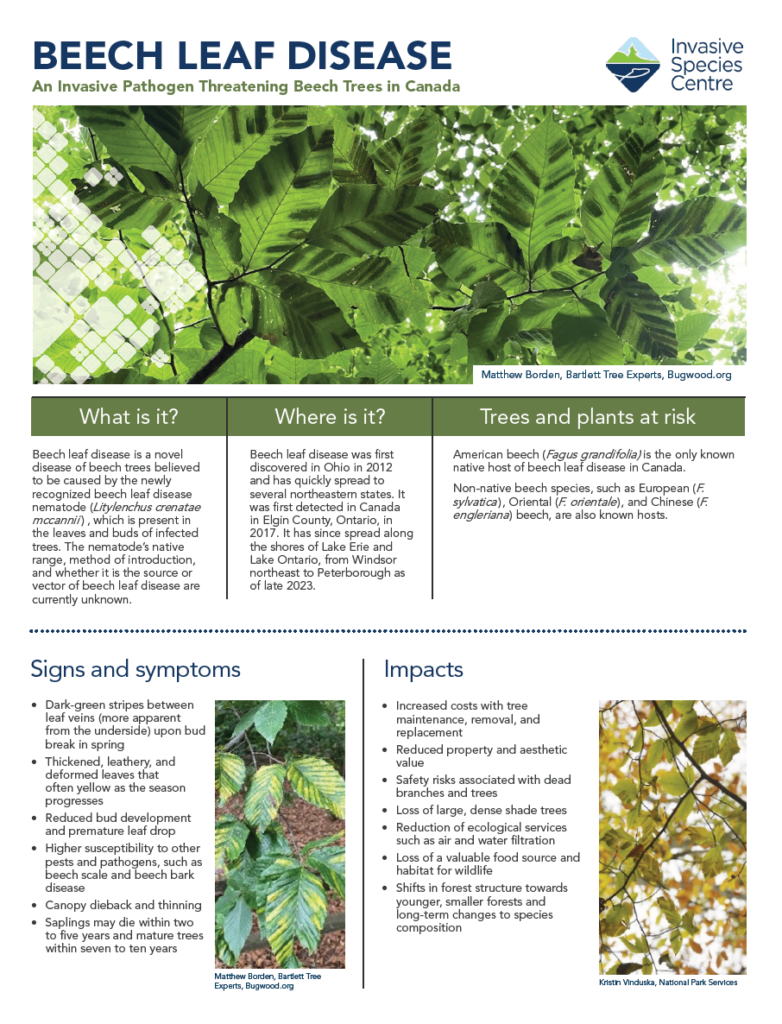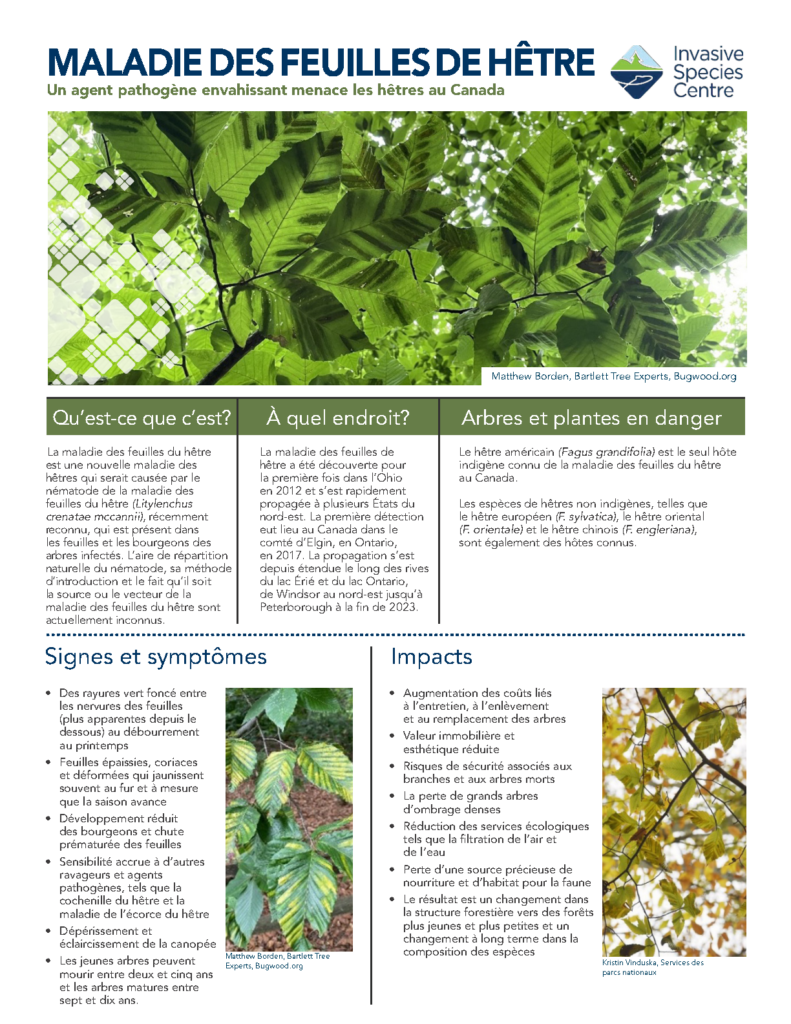Beech Leaf Disease
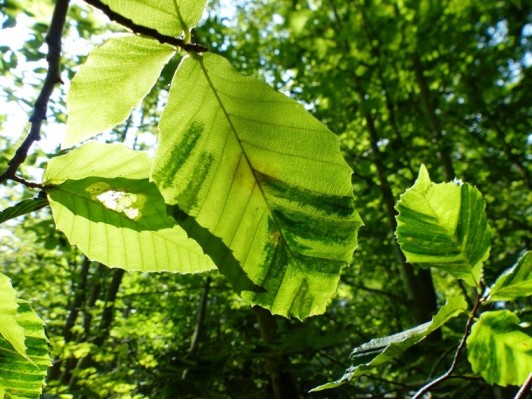
Signs of Beech Leaf Disease; Ohio State University
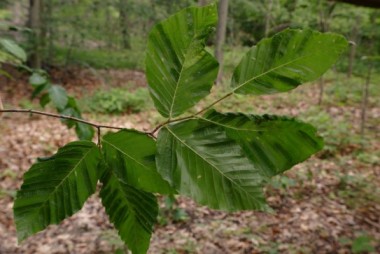
Early stage leaf striping; John Pogacnik, Ohio Department of Natural Resources
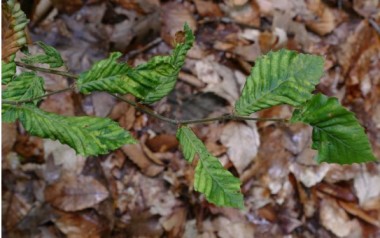
Late stage leaf deformation, photo by John Pogacnik, Ohio Department of Natural Resources
Order: Tylenchida
Family: Anguinidae
Beech leaf disease (BLD) was first discovered in North America in 2012 in Ohio. BLD has spread quickly since its arrival and is now found in several American states and Ontario. This disease is rapidly expansion throughout the Southern Great Lakes region and New York. In Lake County, Ohio BLD has shown a spread rate of 5.05 Km2 from 2013 to 2016 during that time more counties have been added to the infected area with Ontario being added to the infested area in 2017 (Ewing et al., 2018).
Many of these infested areas have shown noticeable changes in the canopy of beech trees with mortality occurring in many saplings as well as larger mature trees. Leading experts in the fields of forest pathology and nematology have isolated an invasive nematode that is believed to be responsible for the disease. Litylenchus crenatae ssp. mccannii is an invasive nematode that is present in the leaves and buds of infected beech trees.
Did you know?
The North American population of beech leaf disease was designated as a new subspecies, since there are morphological differences between this population and populations in the native range of Japan.
Research supports that Litylenchus nematodes are associated with the disease but are unlikely to be the sole vector of infection. Further research is being conducted to determine how BLD spreads between host trees and if there are any other symbiotic relationships that are required for this transmission of this disease from tree to tree. It is possible that the nematode itself may produce a toxin or is associated with another pathogen that leads to the infections observed in BLD infected trees (Carta et al., 2020).
In Ontario populations, Litylenchus crenatae ssp. mccannii can be found on symptomatic leaves between June and August. The nematodes are mainly associated with symptomatic leaves but are also found in much smaller numbers on asymptomatic leaves. From November to March, nematodes were associated with buds and detached leaves more often than they were associated to attached leaves (Reed et al., 2020).
BLD appears to spread very quickly, characteristic of an invasive pathogen, and spread does not appear to be influenced by slope, aspect, or soil conditions. Other nematodes can be spread by mites, insects, animals and in infected plant material. Where BLD is established, nearly 100% of American beech trees show symptoms (Pogacnik & Macy, 2016).
Infected leaves my look similar to other pest and pathogen damage, such as beech blight aphid, European beech scale, erineum patches, and other leaf fungi like anthracnose (Carta et al., 2020). The presents of BLD may increase susceptibility of beech trees to these other forest pests and pathogens causing greater mortality.
BLD is found mainly infecting American beech (Fagus grandifolia) in the forest which are native to North America but has been reported on European beech (Fagus sylvatica) and other ornamental beeches in nurseries. This indicates that the risk of the disease may extend to other species in the genus Fagus spp.
Symptoms of BLD are only observed on leaves and buds.
Less severe symptoms:
- Striping appears on the leaves, caused by darkening between the leaf veins.
- The darkened area is slightly raised and is thicker than the rest of the leaf tissue.
- The striping only appears between the veins.
- This is most apparent when viewing from below.
- Striping is present upon leaf-out in the spring.
- Striping is noticeable throughout the summer and winter months
- Very little premature leaf drop occurs during early stages

Early stage leaf striping; John Pogacnik, Ohio Department of Natural Resources
According to new research, the symptoms seen aren’t progressive as previously thought, some trees may never reach the “leaf curl” stage. It is thought that it is dependent on a variety of other environmental factors; however, research is ongoing. Young trees seem to be more susceptible to mortality than mature trees.
More severe symptoms:
- Leaves near branch tips will become shrivelled, discoloured, and deformed.
- Reduced bud and leaf production will occur

Late stage leaf deformation, photo by John Pogacnik, Ohio Department of Natural Resources
Erineum patch

Powdery Mildew

Anthracnose

BLD was first discovered in Lake County, Ohio in 2012. It is now found in Ohio, Pennsylvania, Connecticut, and New York in the United States. The first detection in Canada was in Elgin County, Ontario in 2017, and has now been detected in four additional counties. Counties where BLD is present in Ontario include Elgin, Chatham-Kent, Norfolk, Oxford, Lambton, Niagara, Haldimand, Middlesex, and City of Toronto. As this disease spread North and Eastward in Ontario new detections become difficult when beech trees are affected by other diseases such as, Beech Bark Disease. Currently BLD infects a small numbers of beech trees, making monitoring for this disease essential for early detection.
Beech leaf disease map showing the spread of the disease between 2012 and 2023. Source: www.clevelandmetroparks.com
Beech trees are already at risk from beech scale and beech bark disease. BLD not only causes juvenile tree mortality but also makes trees more susceptible to other pests and pathogens.
Economic Impacts
Researchers in Ohio have used an online tool to predict economic losses if half of the beech trees in the state were lost. This amounted to $225 million USD in ecosystem services such as water filtration, biodiversity maintenance, carbon sequestration, and aesthetic/recreational value (Ohio State University, 2019). Beech trees are distributed throughout the Great Lakes-St. Lawrence and deciduous forest regions of southern and central Ontario and reduced availability of healthy beech could have similar effects on Ontario’s economy.
Ecological Impacts
Beech trees are valuable nut-producing trees and provide food for many forest dwelling animals. Black bears, for example, rely heavily on beech nuts for food in northern hardwood forests. Loss of beech trees can also cause shifts in forest structure, including a loss of canopy structure, shift towards younger, smaller forests, and long-term changes to species composition (Wilke, 2019).
Social Impacts
Beech trees can grow to be beautiful, large hardwoods, and the loss of these can greatly affect aesthetic value. Canopies are large and provide dense shade. Nature enthusiasts admire the lush foliage that turns electric yellow in the fall, and the smooth gray bark that is often used as canvas (Popkin, 2018). Beech trees are commonly found in deciduous forests stands and urban greenspaces.
As of this time, there is little information on best management practices for BLD since the transmission of this disease in not currently known. The ISC will be updated the best management practices as research on the disease continues.
Prevent
Little is known on the origins or biology of BLD, no effective control or eradication measures have been developed.
Similar to emerald ash borer, it is believed that the human transport of wood products may have distributed this nematode. It is also possible that it has arrived in North America through an invertebrate vector (Carta & Wick, 2018).
Management should focus on preventing the introduction of BLD and containing spread where BLD has established. More research must be conducted on determining the cause of the disease so these types of preventative measures can be developed. In general, the spread of invasive species can be prevented by restricting movement of firewood and natural wood products, conducting beech tree inventories to identify resources at risk, monitoring trees closely for signs and symptoms, increase diversity of tree species, and implement management practices to keep forests healthy.
Research exploring resistance breeding of beech and the understanding of why some trees are more severely infected than others is underway. This work will help to inform both prevention and management activities moving forward as BLD spreads across the landscape.
Respond & Control
As the cause of BLD is unknown, control measures have not yet been determined. Experts have commented that affected areas should be quarantined before spread continues and the disease becomes too widespread to manage. Quarantines will prevent further spread of the disease, allowing researchers time to determine cause and effective control measures. You can help to prevent further spread of this disease by ensuring that you are not moving beech seedlings, the leaf litter from an infected area, or firewood.
Beech Leaf Disease Monitoring Network

The Invasive Species Centre is partnering with the Ministry of Natural Resources (MNR) Science and Research to expand our community science program to include a new species!
Beech leaf disease is a relatively new invasive species in Ontario and appears to be caused by a newly described species of nematode. Scientists have been working to understand more about this species since its detection and need your help!
Since this tree disease is spreading so rapidly, it can be hard for a small group to keep track of! With the eyes of community scientists on the ground helping to give us a better picture of where beech leaf disease is moving, how it is moving, and what we can do to stop or slow the spread.
Being a community scientist means:
- Actively monitoring beech trees in your yard and neighbourhood for signs of decline,
- Knowing what the signs and symptoms of beech leaf disease look like (or knowing where you can refer to!)
- Report! Reports of beech leaf disease made through the Early Detection Distribution Mapping System (EDDMapS) are sent directly to Ontario’s beech leaf disease researchers!
Learn more here.
Fact Sheets
Current Research
Research is currently underway to determine the vector that beech trees are infected by this disease. The best means of control would be selective breeding of resistant trees or and effective way of managing the nematode. However, there is no documented evidence of trees developing resistance or recovering in nature. Microbial profiling is being conducted, comparing what is present on diseased and asymptomatic trees. There are also researchers investigating the association of BLD with the Litylenchus nematode. Long-term monitoring will aid in determining rates of mortality and infection.
References
Carta, Lynn Kay, et al. “Beech Leaf Disease Symptoms Caused by Newly Recognized Nematode Subspecies Litylenchus Crenatae Mccannii (Anguinata) Described from Fagus Grandifolia in North America.” Forest Pathology, vol. 50, 27 Jan. 2020, doi:DOI: 10.1111/efp.12580
Ewing, Carrie J., et al. “Beech Leaf Disease: An Emerging Forest Epidemic.” Forest Pathology, 2018, doi:10.1111/efp.12488.
Ohio State University. “Beech trees are dying, and nobody’s sure why: Intense effort underway to find culprit behind rapid disease spread.” ScienceDaily. ScienceDaily, 9 January 2019. <www.sciencedaily.com/releases/2019/01/190109114758.htm>.
Pogacnik, John, and Tom Macy. “Forest Health Pest Alert – Beech Leaf Disease.” Ohio Department of Natural Resources – Forestry, July 2016, forestry.ohiodnr.gov/portals/forestry/pdfs/BLDAlert.pdf.
Popkin, Gabriel. “An Arboreal Murder Mystery: What Is Killing Beech Trees?” The Washington Post, WP Company, 28 July 2018, www.washingtonpost.com/national/health-science/an-arboreal-murder-mystery-what-is-killing-beech-trees/2018/07/27/95d18ebc-8c59-11e8-a345-a1bf7847b375_story.html?utm_term=.13abd693d4d8.
Reed, Sharon, et al. “Foliar Nematode, Litylenchus Crenatae Ssp. Mccannii, Population Dynamics in Leaves and Buds of Beech Leaf Disease-Affected Trees in Canada and the US.” Forest Pathology, vol. 50, 23 Apr. 2020, doi:DOI: 10.1111/efp.12599.
Wilke, Caroline. “A Mysterious Disease Is Killing Beech Trees.” News & Opinion | The Scientist Magazine®, The Scientist Magazine, www.the-scientist.com/news-opinion/a-mysterious-disease-is-killing-beech-trees-65358.


